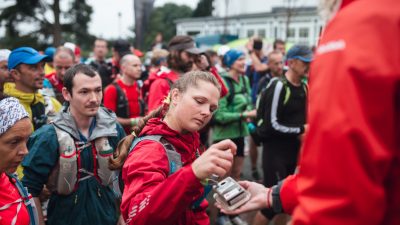Home » News » Top 5 Fueling Tips for running Ultra Distance Sky Races
At Longhaul Endurance we believe this principle applies to all endurance sports, so we have put together our Top Tips to help you develop a fuelling strategy that really works for you!
Why is fuelling so important in endurance sports?
The number one reason for the dreaded DNF in an ultra marathon is gastro-intestinal (GI) distress. This is caused by our digestive systems being unable to break down and utilise the fuels we put in. For shorter distances our gut can cope with an unplanned, randomised fuelling strategy of an energy gel here and an electrolyte there. But for ultra-events this “winging it” approach to fuelling just leads to GI, and in turn performance, disasters.
When we start any physical activity our body re-routes blood away from the digestive system to our muscular system, switching the gut to hibernation mode. After around 90-minutes of exercise our stored muscular energy, glycogen, becomes depleted, needing us to re-fuel to sustain our performance. As soon as we start to eat we are asking our dozing digestive system to break down and utilise our fuels. Sadly, our gut is a little like us, grumpy, ineffective and problematic, if asked to work immediately after being woken!
Longhaul’s Top Tips for Optimizing Race Day Nutrition:
1. Practice makes perfect: Training your digestive system to break down and utilise food during exercise is as important as training your cardiovascular and muscular systems. By practicing fuelling during your long training sessions you not only decrease your chances of gastro-intestinal distress during an event, but you also get the opportunity to test out different foods and timing strategies in different weather conditions and on differing terrains. Through practice, practice, and more practice you will be able to discover your perfect race day fuelling protocols.

2. Stay hydrated: When it comes to perfecting your endurance nutrition, how much you drink is as important as what you eat. Our digestive system needs water to transfer the energy from digested food from our gut into our blood stream. Without a critical level of water the food just sits there like a heavy brick, causing discomfort, bloating, gas and nausea. To compensate, the body may start to shunt water from other parts of the body, such as your muscular system. This redirection of water is likely to have negative ‘side effects’ such as to cause cramping. But, if you are working at any kind of intensity it will continue to prioritise using water (as sweat) to regulate your body temperature. This leaves you with insufficient water for digesting food, and a whole host of potentially uncomfortable gut symptoms.
3. Little and often: Don’t overload your digestive system. An endurance event is not the time for stressing the gut by eating a lot in one go. As our digestive track is working in eco-mode it prefers a little fuel, taken often. Try to maximise calorie intake to 200-300 calories per hour. More than this, especially high levels of simple carbohydrates, leads to gastric distress, as the bacteria that works to break down sugars in the gut create a significant amount of gas, bloating and feelings of nausea.

4. Develop your A, B & C fuelling strategies: As endurance athletes we are continually problem solving as we adapt to the changing environment and challenges in front of us. If we rigidly stick to Game Plan A and do not adapt to situations as they evolve, we increase our risk of getting GI issues. Therefore, it is important to develop different fuelling strategies to cope with dramatic changes in weather, long distances between aid stations, aid stations not having the fuels you were expecting, food fatigue, fatigue causing poor decision making, and the many other fuelling difficulties an athlete can face out on the course. All these different strategies should be practiced during training but don’t be afraid to adapt further on race day if a new challenge presents itself.
5. Don’t do anything new on race day: You wouldn’t (I hope!!!) try a new pair of trainers on race day. Nor should you add anything new to your fuelling protocol. Remember experimentation is what you do during training NOT on race day! Your chances of gastro-intestinal distress and in turn DNF increases dramatically when you throw something new into your body. So, keep away from any new foods at fuelling stations, no matter how tempting they seem! Trust in your training, and don’t rely on luck!
** 1. Jason Koop with Jim Rutberg: Training Essentials for Ultra-Running

40km of mountain terrain and 3500m ascent/decent: Scafell Sky Race is played out on technical, single-track trails from

The NEW design, Lake District Sky Trails, sky races are all ready for entries to open on the 1st November 2018.